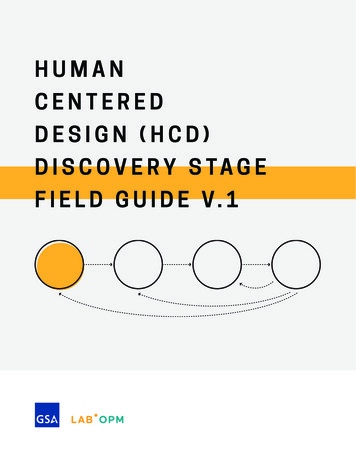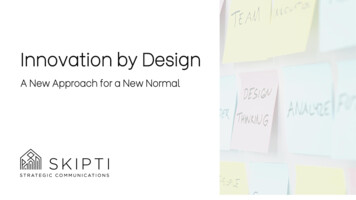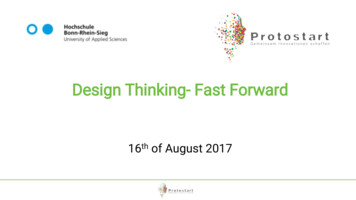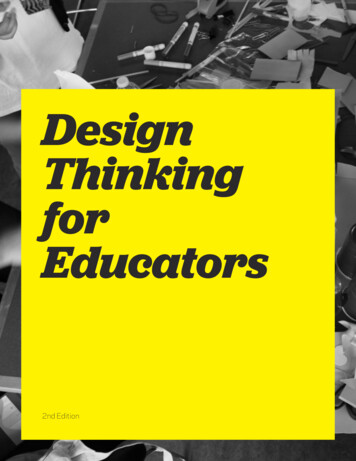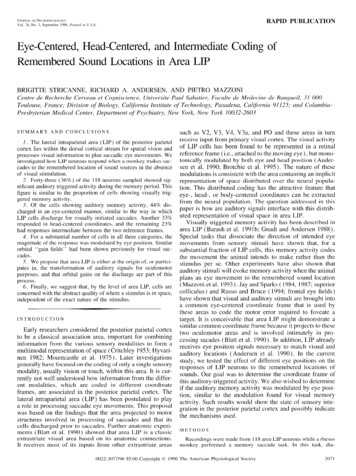
Transcription
DESIGN THINKING FOR HUMANCENTERED HEALTH CAREApril 14, 2021Sponsored by:
Upcoming Team Training EventsWebinarsMay 12, 2021 12:00 – 1:00 PM ETRegister for the webinar “Culture Team-Based Care Improves Value”Virtual Courses & WorkshopsRegister for our new virtual workshop series (April 20th – May 11th): Improving Team Structure:Engaging Patients and Families as Team Members explore strategies that align the principles andpractices of patient and family engagement with your organization’s overall teamwork andcommunication initiativesOnline Community PlatformJoin Mighty Network to access exclusive content and connect with your peers to share stories, tools,and content.
AHA’s Advancing Care ConferenceInterested in learning more about Team Training’s new conference? Check out our website for more information!
We help health systemsimprove their patients’ &employee experiencethrough real-timefeedback and servicerecoveryQuality Reviews Inc.
How it WorksPatient leaveshospital or clinicPatient receives SMStext with HIPAAsecure survey linkPatient fills outsurvey onsmartphoneSurvey data updatedin real-time analyticsdashboardQuality Reviews Inc.
Some Notable Clients
Edward Shin, MDed@q-reviews.com(646) 418–3015141 W. 28th Street9th Floorq-reviews.comNew York, NY 10001Quality Reviews Inc.
Today’s PresenterJennifer Calzada, MA, MPHDirector for Simulation, Tulane School ofMedicineTeamSTEPPS Master TrainerAHA Center for Health Innovation AdvisoryBoardCertified in Human Centered Healthcare
Today’s ObjectivesParticipants will. Define Human Centered Healthcare and Design Thinking. Describe design thinking application to a healthcare system. Apply design thinking techniques to healthcare systems. Describe design thinking techniques that integrate into healthcare systems.
DESIGNTHINKINGHUMANCENTEREDHEALTHCARE
WEBINAR LEARNING OBJECTIVES Define Human Centered Healthcare and Design Thinking. Describe design thinking application to a healthcaresystem. Apply design thinking techniques to healthcare systems. Describe design thinking techniques that integrate intohealthcare systems.
WHAT ISHUMAN CENTEREDHEALTHCARE
HEALTH SYSTEMS Health systems are complex and constantly changing Changing regulationsWorkforce changes in numbers and makeupGenerational changes in employee expectationsPatient expectationsCompetitive landscapeChanging and improving technologyChanging and improving capabilities
HUMAN CENTERED HEALTHCAREBusinessneedsoriginate fromtop downHuman needsoriginate frombottom up
HUMAN CENTERED HEALTHCAREThe center of healthcareplanning and decisionsshould be the patient,family, and care teaminvolved in the process.TeamSTEPPS has it right!
HUMAN CENTERED HEALTHCARETeamSTEPPS places allthese people at the centerof healthcare decisions,but who else should be inthis chart?
HUMAN CENTERED HEALTHCARE Patient and healthcare team needs should be prioritizedin process planning. Human needs and experiences should be the focus ofchange, while trying to fit business needs. Not the otherway around. Example: Business focus would ask how can we get morereferrals to our surgeons. Human focus asks how can weensure our surgeons are providing the highest quality care.
UNDERSTANDDESIGN THINKING
SYSTEMS THINKING Systems Thinking is way to approach projects, as systems arecomplex and made up of interconnected parts. Changes or improvements to one component can affect othercomponents, even negative affects. Systems Thinking is a way to account for this connected state andconsider affects on all parts of the system. Solving one problem should not create others.
SYSTEMS THINKINGTop-down processCommon Process:Business need sparks change3.Human y / capabilitiesplanned to meet business needNegative affects on humanneeds averted, but positiveoutcomes not always a priority
DESIGN THINKING“Design thinking is a human-centered approach toinnovation that draws from the designer’s toolkit tointegrate the needs of people, the possibilities oftechnology, and the requirements for business success.”Tim Brown, Executive Chair of IDEO 1
DESIGN THINKINGFlip the Process:Human needs prioritized1.Human y / capabilitiesdetermine what is possibleAll possible options are reviewedfor fit with business needsBottom-up process
DESIGN THINKING PROCESS Many system planning processes start with the business need.The first circle that is considered is the business need. Example: A clinical practice needs to increase revenue by10%. Design thinking states you should start with the human need first.Empathy and buy-in are built-in to this process. Example: Physician and patient need to increase timetogether for primary care appointments to improve patientsatisfaction and outcomes. Which process is going to produce better patient care?
DESIGN THINKING:A REAL HEALTHCARE EXAMPLE Real world example of design thinking for physicians and nurses. Major trauma center in New York works like many others– when apatient arrives, the trauma bed is ready, supplies are ready, and aninterdisciplinary team of up to 20 are ready to spring into action. Except one difference created by a nurse – the trauma leaderalways wears a bright orange vest. This change allows the leader to be quickly identified, easily visible,and has improved team communication. 2
DESIGN THINKINGTOOLS
DESIGN THINKING TOOLS Visual based and collaborative in nature. Tools available for all the steps of managing change. Visualize the system, components, and connectionsMap stakeholdersBuild empathy and buy-inReframe the challengeEnvision the changeCommunication and implement change
SYSTEM MAPPING: CLUSTER MAP 3Visualize the systemon one map withconnectionsbetweencomponents, whichincludes allstakeholders.
SYSTEM MAPPING: CAUSAL LOOPReduced staffretentionCommunication &Teamwork failuresIncreaseduninsured costsIncreasedadverse eventsLowerstaffmoraleVisualize thesystem and thespecific causeand effectconnectionsbetween parts.
SYSTEM MAPPING: MORE EXAMPLES 3More examples tovisualize systems,components, andconnections.
STAKEHOLDER MAPSPrioritize yourstakeholders, butalso make sure youinclude stakeholdersfrom all levels ofinfluence.Who is at center of theexperience?Who has direct influenceon the experience?Who has indirect influence onthe experience?
STAKEHOLDER INTERVIEWS Goal to provide deep qualitative data at the early stagesof a change project. Identify needs and goals of each type of stakeholder. Build trust and buy-in from different types of stakeholders. Example: If you’re going to change the pre-op process,what stakeholders need to provide input?
EMPATHY MAP 4WHO are we empathizing with?WHAT do they need to do?What do they THINK?What do they SEE?What do they HEAR?What do they SAY?What do they FEEL?What do they DO?Key for patient needs.This framework helpsteams understandhow the healthcaresystem is experiencedby different users. Thisdeep understandinghelps build empathyand buy-in.
SHADOWING Observe and interact with stakeholders in their real workenvironment. Innovation observers create lists of human needs, categorize thoseneeds, and connect to specific steps in the work experience. Deepens the understanding of stakeholder roles. Observers may pick up on forgotten or automatic work steps.
DESIGN WORKSHOPS Also called co-creation workshops. Similar to interviews, but done as a collaboration processwith diverse perspectives. Brings diverse stakeholders together to focus on aproblem. Should include decision makers and frontline employees. Example: ALL members of Neuro ICU brought together toco-create new ICU policies.
HOW MIGHT WE STATEMENT 5 Utilize language to open creativity, reduce pre-judgingoptions, and prevent mental limitations. How might we do x? HOW implies there IS a solution. MIGHT implies your idea may or may not work, withoutpre-judging. Example: How might we reduce ED wait times by 25%?
DESIGN WORKSHOP EXERCISE Reframe Challenges, good for ambiguous and complexproblems. Exercise helps break teams out of traditional thinking. Can break out creative solutions. Start with your Challenge Question. Example: How Might We reduce ER wait times by 25%?
REFRAME CHALLENGE EXERCISE 6 Challenge Statement in the middle. Above the line are all thestatements WHY you want toachieve the goal. Below the line are all the WHAT ISSTOPPING US questions. Reframe questions as How MightWe
PLAYBOOKS The playbook puts together all your findings into a conciseand visual action guide for your organizations project. All the steps you take during your planning process, shouldbe communicated in the playbook. This action plan shows – the system, the components, theirconnections, stakeholder list, different stakeholder needsand goals, options that were considered, and finalrecommended actions to reach the final goals.
TEAMSTEPPS &DESIGN THINKING
CHANGE MANAGEMENT Do you feel like we have been discussing the TeamSTEPPSChange Management module? Design thinking is a process to manage change. Human centered design ensures human needs are thefocus of that change.
CREATING A CULTURE OF SAFETY Human centered design principles and tools align with thechange management process. After building a guiding team, the human needs of thesystem should be the focus of developing a changevision. This focus will help ensure buy-in is built in.
TOOLS FOR TEAMSTEPPS Design thinking tools work as templates for creating a changestrategy and action plan (or playbook). System cluster map to identify all components of your system Interconnected Circles or Causal Loops to identify connections andeffects of your planned change Stakeholder interviews or Shadowing to gain early feedback, buy-in,and research Design workshops to bring disciplines and teams together forcollaboration “How Might We” statements to inspire creativity and openness Playbook to guide rollout and actionable steps
CONCLUSIONS Design thinking provides visual tools that are collaborative Human centered healthcare utilizes these tools to keephuman needs as the focus TeamSTEPPS focuses on human connections andcollaborations and benefits from these tools Design thinking provides tools for creating a changestrategy and communicating actionable steps
QUESTIONS?PRESENTER CONTACT:Jennifer Calzada, MA, MPHTulane School of Medicinejcalzada@tulane.edu
REFERENCES1. Design Thinking Defined, https://designthinking.ideo.com/2. A Kalaichandran. Design Thinking for Doctors and Nurses. The New York Times. August 28,2018.3. System Map examples, tems-thinkerssystems-mapping-2db5cf30ab3a4. Empathy Map Worksheet, xplane.com, Accessed 3/19/21.5. W Berger. The secret phrase top innovators use. Harvard Business Review. September 17,2012. Harvard Business School Publishing Corporation.6. Challenge Mapping Part 1 – Challenge Map Basics. September 9, 2019.7leaguestudio.com. Accessed 3/19/21.
HEALTHCARE PLAYBOOK EXAMPLES Hartford HealthCare Clinical Care Playbook Playbook for Population Health AHA Physician Alliance Well-Being Playbook AMA Digital Health Implementation Playbook Patient Engagement Playbook (example of online version)
RECOMMENDED LINKS TO LEARN MORE Design Thinking for Educators Toolkit ators Xplane.com Worksheets - https://xplane.com/worksheets/ Customer JourneyEmployee Experience JourneyEmpathy MapPain/Gain Empathy MapsHigh Performing Teams GoalsRapid Reframing BrainstormingRapid Reframing Communications
HUMAN CENTERED HEALTHCARECERTIFICATE The New School (NY, NY) Continuing & Professional Education3 course certificateDesign Thinking for Human Centered HealthcareDesigning Care Experiences & InteractionsDesigning Care Services & Systems
Questions? Stay in Touch!www.aha.org/teamtrainingEmail: teamtraining@aha.org Phone: (312) 422-2609
DESIGN THINKING “Design thinking is a human-centered approach to innovation that draws from the designer’s toolkit to integrate the needs of people, the possibilities of technology, and the requirements for business succes
